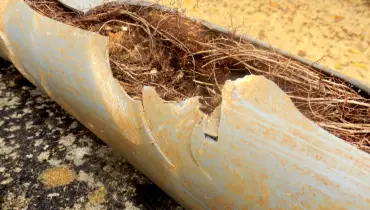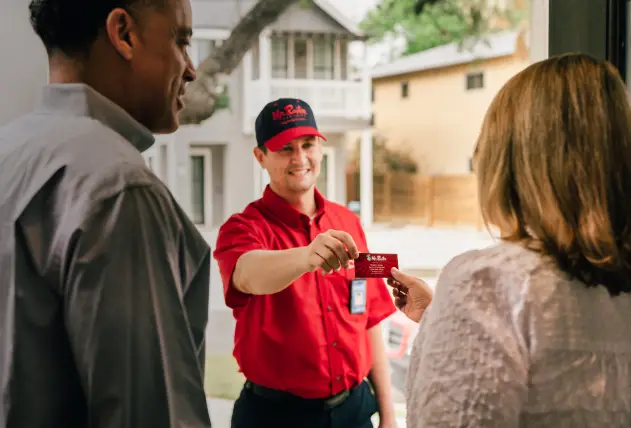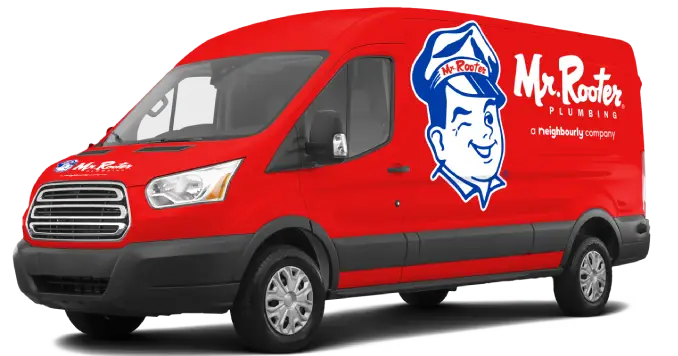
Property owners know there are few plumbing emergencies more stressful than an indoor burst freshwater line, but there’s one other that may take the cake—the invasion of tree roots in a sewer line. When tree roots make their way into loose joints in your underground pipe system, wastewater debris can get caught on roots and lead to a clog. As the pressure around the clog builds, one thing is sure to happen: your sewer drain will back up into your home. This can be costly and dangerous. The presence of raw sewage is both harmful to your health and expensive to repair.
With the help of an experienced Edmonton plumber from Mr. Rooter Plumbing of Edmonton, you can remove tree roots from your sewer line before the problem gets out of hand. A professional plumbing company will conduct regular inspections to spot potential problems before they become more serious. Whether you suspect that you currently have tree roots in your sewer lines or you’ve had them in the past and want to know how to prevent them from occurring again, this helpful article will teach you everything you need to know.
The Danger Tree Roots Pose to Sewer Pipes
Trees are more interesting than you might think. While you may take notice of them when they start to bud after a long, bleak Edmonton winter, they otherwise aren’t likely to regularly grab your attention. If you look up illustrations of trees and their roots, you'd see many images of trees with roots extending down into the earth almost as deep as the trunk and branches are tall. A drawing by an arborist would probably look much different, as tree roots don’t grow this way at all.
Given enough space to do so, tree roots will choose to grow horizontally before they grow vertically. In fact, most roots extend less than 20 inches below the earth's surface. The reason for this is quite simple—tree roots will go where the resources they rely on are most likely to be found. These resources primarily include oxygen and water, which tend to be higher up.
When sewer and water lines develop tiny cracks and leaks, water seeps into the surrounding soil. Root systems sense this leak and grow towards it in their quest to find water. Once they’ve found it, no matter how small the crack in the pipe is, they’ll find their way inside of it and cause more significant damage to the pipe. As roots grow, loose joints in underground pipes will be pulled further apart. Tree roots are also able to cause clogs if big enough.
Some pipe materials are more susceptible to tree root damage than others. On your Edmonton property, you may have the following types of pipes:
- PVC. Most new homes use polyvinyl chloride (PVC) pipes for their sewer system. If your home was built after the 1970s, there’s a very good chance that PVC was used to construct your system.
- Cast Iron. Most homes built before 1980 in Edmonton will have cast iron drains below the basement slab, however, very few have cast iron sewers.
- Clay. Clay was once a popular material for sewer pipes, thanks to its durability. Although clay pipes are fairly durable, they’re much more susceptible to shattering when invaded by a tree root than PVC and iron pipes. For this reason, plumbers don’t recommend choosing clay for new house builds.
At the end of the day, it’s not so much the tubing itself that needs to be durable to prevent tree roots in a sewer line, but rather the joints between each segment need to be strong and tight to prevent major damage from occurring.
Tree Roots in Sewer Line: Common Warning Signs
You don’t have any large trees on your property, so you couldn’t have any tree roots in a sewer line, right? You may be alarmed to learn that the big, glorious oak tree in your next-door neighbor’s yard might have spread its roots underneath your entire property. Depending on the type of tree, root growth tends to spread between two and three times the distance of the canopy. Thus, the bigger the tree, the longer the roots.
Now that you know you could have a sewer line problem thanks to your neighbor’s landscaping decisions, how do you find out if a leak has actually occurred? Signs of tree root invasion in your sewer and water systems aren’t always obvious, but some indications include:
- Toilets that no longer flush properly. Does your toilet seem to drain ever so slowly? Does it also make a gurgling noise? If you’ve tried plunging to no avail, don’t keep trying, or you could risk a sewer backup, as both of these occurrences are symptoms of a clogged sewer line. It may be a tree root clogging your line or something that was accidentally flushed down your drain. Either way, these are signs that it’s time to contact a plumber for clog removal.
- Pooling water in your yard. If tree roots have been growing in your sewer lines for a while, they may no longer just be leaking but breaking apart. Even PVC pipes can break if enough pressure is applied. When this happens, you may notice that a particular area of your yard is a little more wet and spongy than the others. It may also be greener, thanks to the fertilization benefit that sewage provides, or foul odors may be present.
- Results of a professional plumbing inspection. Some plumbing issues are complicated to diagnose. If you suspect some sort of problem with your plumbing system, contact us about our residential plumbing camera inspection service. By inserting a tiny camera down into your pipe system like we would a drain snake, we will find out exactly what state your pipes are in using live video footage. If you’ve recently moved into an older home, a plumbing inspection is recommended regardless of whether or not you’re currently experiencing any issues.
Removing Tree Roots in Sewer Line
If you’d prefer to try some DIY fixes before calling in the dream team at Mr. Rooter Plumbing of Edmonton, you can give these two methods a shot:
Flush Foaming Root Killer Down the Drain
Root killers are chemical products formulated specifically to eliminate root clogs in your plumbing system. Foaming root killers used today are power products that expand once combined with water. Essentially a pesticide, this product kills tree roots and can also prevent them from growing back.
Copper sulfate was once a popular type of root killer, but it’s fallen out of use due to its extreme toxicity to pets and ability to damage pipes. Most hardware stores in Canada don’t sell copper sulfate, but it can still be purchased online. Avoid purchasing this product, even if someone you know recommends it.
Note that while this may temporarily kill roots in the drain, it won’t remove them, so you’ll still have to have the roots removed to get things flowing again.
Professional Tree Root Removal in Edmonton
To effectively remove tree roots in your sewer line, the best thing to do is call a professional plumbing company. Without the expertise of a plumber, the decision to flush foaming root killers down the drain is based on nothing more than your best guess. If your clogged drain pipes aren't the result of tree roots, you’re just wasting your time while allowing the problem to get worse.
Additionally, if there are tree roots in your sewer line, simply killing the roots won’t be enough to solve the problem. The roots were able to invade your sewer line pipes because your pipes already had a leak. This leak will need to be fixed by a professional plumber, who not only has all the specialized equipment necessary to repair your lines but also prevent the problem from arising again in the near future.
Preventing Tree Roots in Sewer Lines
Most professional plumbers will tell you that preventive measures are the best approach to almost all types of plumbing issues. The same is true for invasive tree roots in your sewer line. Tree roots in sewer lines can be largely prevented by taking the following proactive precautions:
- Make landscaping decisions with your plumbing system in mind. When deciding on the location and type of tree that you'd like to plant in your yard, consider how close it will be to your sewage system, as well as the projected root growth for the tree type. If you have a massive tree on your property already, it will be worthwhile to consider tree removal. If the thought of this bothers you, don't worry—you can plant smaller trees better suited to the city in its place.
- Replace old pipes. Many people dream about living in a beautiful, historic home, but homeowners tend to pay a financial price for this experience. If your water and sewer lines are four decades old or more, you’ve probably already had to call in a plumber to perform repairs at one time or another. The older they get, the more often you’ll need to do repairs. At a certain point, it becomes more economical to just get your entire system replaced.
- Get regular plumbing inspections. It’s hard for people to see the value in the cost of an inspection until a plumbing emergency occurs. Though it may feel like you’re shelling out cash unnecessarily to get semi-annual or annual plumbing inspections done, the cost of repairs in the event of a plumbing emergency will cost you much, much more.
Cost Of Tree Root Removal In Edmonton
Understandably, you want to know just how much you can expect tree root removal in Edmonton to cost, but it’s difficult to give even a ballpark range. Generally, you can expect to spend $300 at a minimum, but if the tree root damage is extensive and you have a burst pipe on your hands, the cost of removal and repair can be several thousands of dollars.
Homeowner's insurance policies don't tend to cover repairs to prevent tree roots in sewer lines, however, if it has progressed to a point where damage has occurred, you may qualify for a repair or replacement depending on your insurance policy.
Because the leak begins underground and is not visible by sight, some companies may cover damage that occurs from tree roots in a sewer line. To find out what you’re covered for, check out the fine print on your insurance policy.
Tree Roots in Sewer Line? Contact Mr. Rooter Plumbing of Edmonton Today!
We understand just how stressful damage caused by tree roots in your sewer line can be. Needing underground pipe repair can be especially stressful, as your landscaping may need to be ripped up, causing you to have to pay not just for the plumbing repair but for landscaping services, too. Whether you’re in Edmonton or surrounding areas, such as Sherwood Park or St. Albert, you can count on our quality workmanship.
We strive to give our customers peace of mind by addressing plumbing problems with the least invasive method possible. Tree root removal in Edmonton can be done non-invasively with pipe relining service and trenchless sewer repair, and at Mr. Rooter Plumbing of Edmonton, we use these strategies all the time.
For professional service, upfront pricing, 24/7 emergency services, and a satisfaction guarantee contact us today for a plumbing inspection or our tree root removal service. To get in touch, simply give us a call, or fill out our online job estimate request form to schedule a free, no-obligation in-person consultation.

